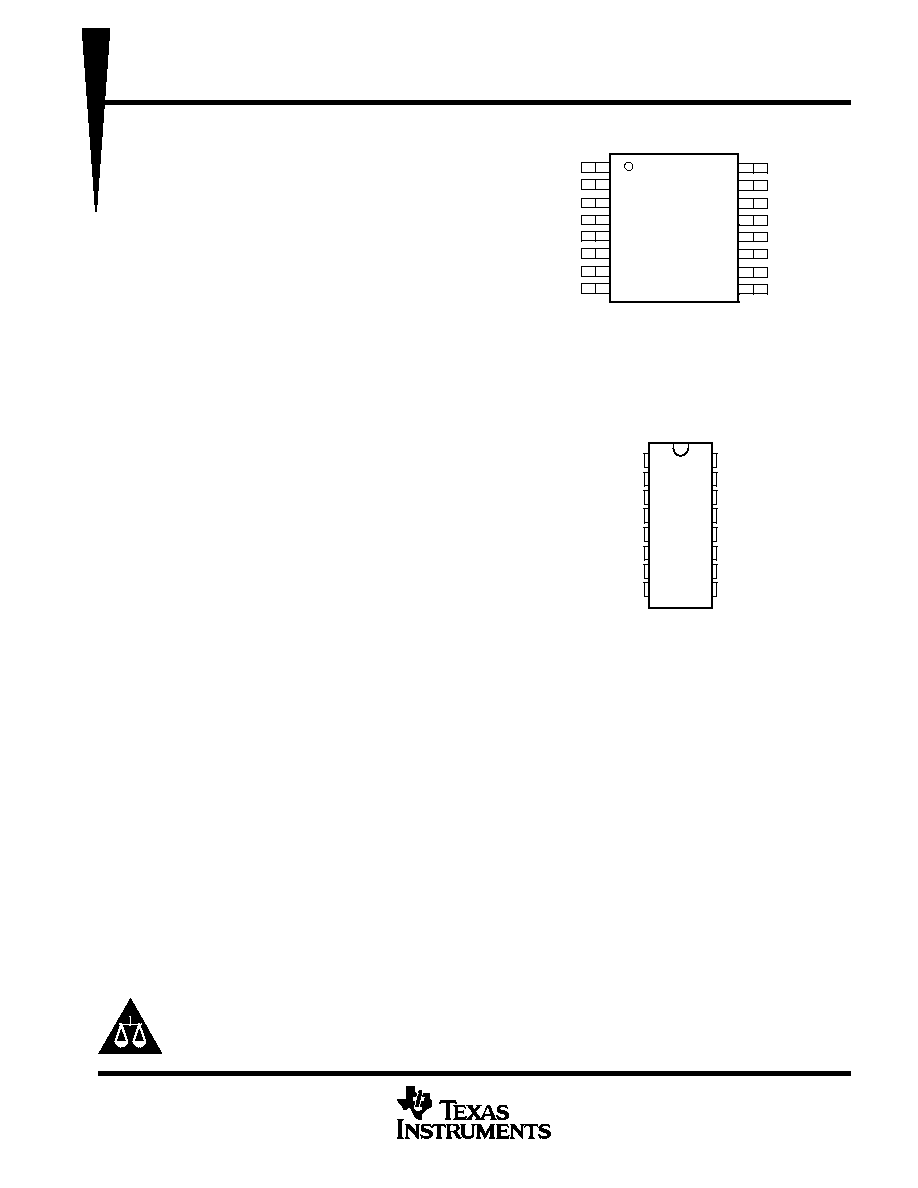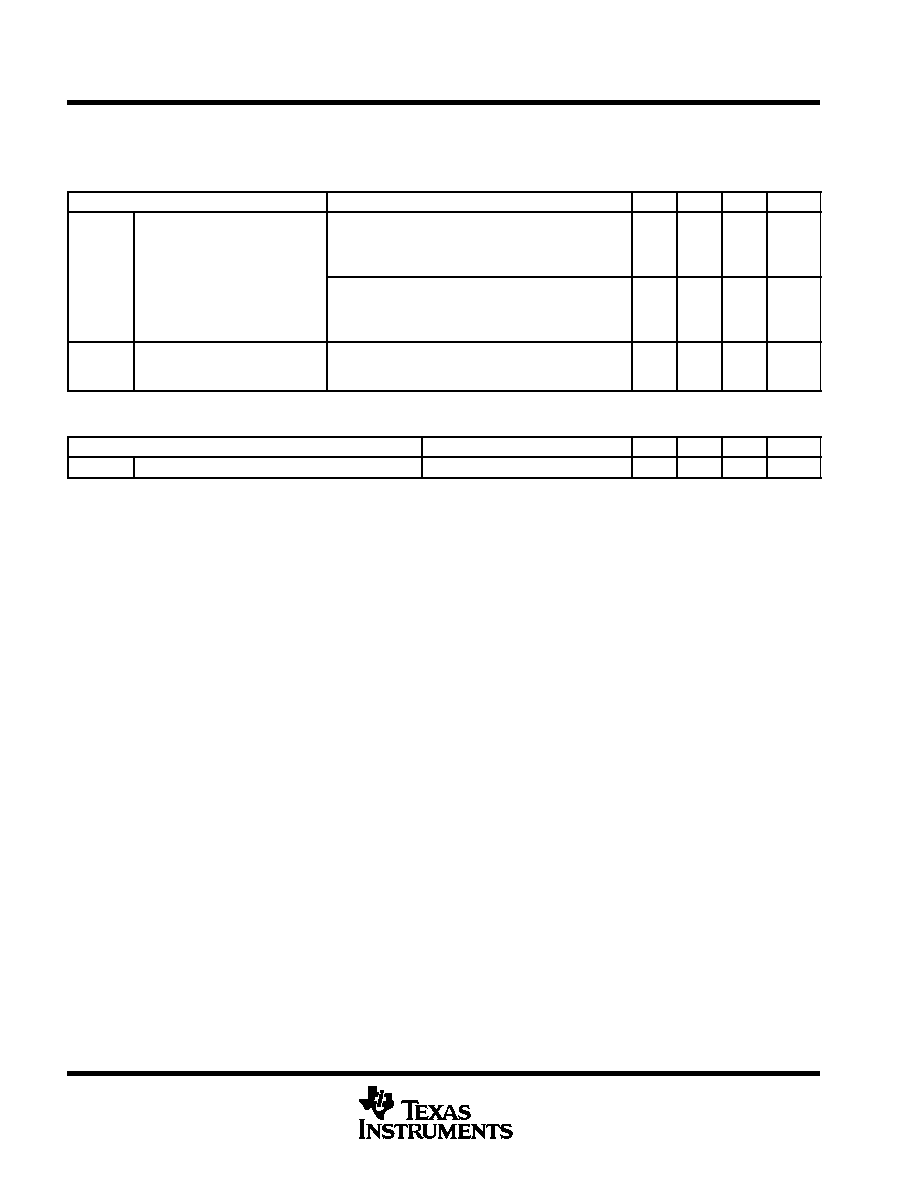 | –≠–ª–µ–∫—Ç—Ä–æ–Ω–Ω—ã–π –∫–æ–º–ø–æ–Ω–µ–Ω—Ç: UCC3952 | –°–∫–∞—á–∞—Ç—å:  PDF PDF  ZIP ZIP |

UCC3952-1, UCC3952-2, UCC3952-3, UCC3952-4
Single Cell Lithium Ion Battery Protection IC
SLUS400D ≠ AUGUST 2000
1
POST OFFICE BOX 655303
∑
DALLAS, TEXAS 75265
D
Protects Sensitive Lithium-Ion Cells From
Overcharging and Over-Discharging
D
Dedicated for One-Cell Applications
D
Integrated Low-Impedance MOSFET Switch
and Sense Resistor
D
Precision Trimmed Overcharge and
Overdischarge Voltage Limits
D
Extremely Low Power Drain
D
3-A Current Capacity
D
Overcurrent and Short-Circuit Protection
D
Reverse Charger Protection
D
Thermal Protection
description
The UCC3952 monolithic BiCMOS lithium≠ion
battery protection circuit increases the useful
operating life of a one-cell rechargeable battery
pack. Cell protection features include internally
trimmed charge and discharge voltage limits,
discharge current limit with a delayed shutdown,
and an ultra-low-current sleep mode state when
the cell is discharged. Additional features include
an on-chip MOSFET for reduced external compo-
nent count and a charge pump for reduced power
losses while charging or discharging a low-cell-
voltage battery pack. This protection circuit
requires one external capacitor and can operate
and safely shut down in a short circuit condition.
Copyright
©
2000, Texas Instruments Incorporated
PRODUCTION DATA information is current as of publication date.
Products conform to specifications per the terms of Texas Instruments
standard warranty. Production processing does not necessarily include
testing of all parameters.
Please be aware that an important notice concerning availability, standard warranty, and use in critical applications of
Texas Instruments semiconductor products and disclaimers thereto appears at the end of this data sheet.
1
2
3
4
5
6
7
8
16
15
14
13
12
11
10
9
TCLK
NC
BNEG
BNEG
BNEG
BNEG
BNEG
BNEG
PACK+
CBPS
NC
PACK≠
PACK≠
PACK≠
PACK≠
PACK≠
PW PACKAGE
(TOP VIEW)
1
2
3
4
5
6
7
8
16
15
14
13
12
11
10
9
DP PACKAGE
(TOP VIEW)
TCLK
NC
NC
SUB
SUB
BNEG
BNEG
BNEG
PACK+
CBPS
NC
SUB
SUB
PACK≠
PACK≠
PACK≠

UCC3952-1, UCC3952-2, UCC3952-3, UCC3952-4
Single Cell Lithium Ion Battery Protection IC
SLUS400D ≠ AUGUST 2000
2
POST OFFICE BOX 655303
∑
DALLAS, TEXAS 75265
application diagram
1
3
2
4
5
7
6
8
16
14
15
13
12
10
11
9
0.1
µ
F
3 k
TCLK
N/C
BNEG
BNEG
BNEG
BNEG
BNEG
BNEG
PACK ≠
NC
CBPS
PACK +
LOAD
CHARGER
+
PACK ≠
PACK ≠
PACK ≠
PACK ≠
AVAILABLE OPTIONS
PACKAGES
TA
TSSOP≠16 (PW)
SOIC≠16 (DP)
UCC3952PW≠1
UCC3952DP≠1
≠20
∞
C to 70
∞
C
UCC3952PW≠2
UCC3952DP≠2
≠20
∞
C to 70
∞
C
UCC3952PW≠3
UCC3952DP≠3
UCC3952PW≠4
UCC3952DP≠4

UCC3952-1, UCC3952-2, UCC3952-3, UCC3952-4
Single Cell Lithium Ion Battery Protection IC
SLUS400D ≠ AUGUST 2000
3
POST OFFICE BOX 655303
∑
DALLAS, TEXAS 75265
absolute maximum ratings over operating free-air temperature (unless otherwise noted)
Supply voltage (PACK+ to BNEG)
7 V
. . . . . . . . . . . . . . . . . . . . . . . . . . . . . . . . . . . . . . . . . . . . . . . . . . . . . . . . . . . . .
Maximum forward voltage (PACK+ to PACK≠)
16 V
. . . . . . . . . . . . . . . . . . . . . . . . . . . . . . . . . . . . . . . . . . . . . . . . .
Maximum reverse voltage (where PACK+ to BNEG = 5V)
≠8 V
. . . . . . . . . . . . . . . . . . . . . . . . . . . . . . . . . . . . . . .
Maximum cell continuous charge current
3 A
. . . . . . . . . . . . . . . . . . . . . . . . . . . . . . . . . . . . . . . . . . . . . . . . . . . . . . .
Junction temperature, T
J
≠55
∞
C to 150
∞
C
. . . . . . . . . . . . . . . . . . . . . . . . . . . . . . . . . . . . . . . . . . . . . . . . . . . . . . . . . .
Storage Temperature range, T
stg
≠65
∞
C to 150
∞
C
. . . . . . . . . . . . . . . . . . . . . . . . . . . . . . . . . . . . . . . . . . . . . . . . . . .
Stresses beyond those listed under "absolute maximum ratings" may cause permanent damage to the device. These are stress ratings only, and
functional operation of the device at these or any other conditions beyond those indicated under "recommended operating conditions" is not
implied. Exposure to absolute-maximum-rated conditions for extended periods may affect device reliability.
NOTE 1: Currents are positive into, negative out of the specified terminal. Consult Packaging Section of Data Book for thermal limitations and
considerations of packages. All voltages are referenced to GND.
electrical characteristics, T
A
= ≠20
∞
C to 70
∞
C, all voltages are with respect to BNEG (unless
otherwise stated)
state transition threshold
PARAMETER
TEST CONDITIONS
MIN
TYP
MAX
UNITS
UCC3952≠1
4.15
4.20
4.25
V
Normal to overcharge voltage
UCC3952≠2
4.20
4.25
4.30
V
V(OV)
Normal to overcharge voltage
UCC3952≠3
4.25
4.30
4.35
V
UCC3952≠4
4.30
4.35
4.40
UCC3952≠1
3.85
3.90
3.95
V
Overcharge to normal recovery
UCC3952≠2
3.90
3.95
4.00
V
V(OVR)
Overcharge to normal recovery
voltage
UCC3952≠3
3.95
4.00
4.05
V
g
UCC3952≠4
4.00
4.05
4.10
V(UV)
Normal to undercharge
2.25
2.35
2.45
V
V(UVR)
Undercharge to normal recovery
2.55
2.65
2.75
V
td(OD)
Overcharge delay time
10
25
40
ms
short circuit protection
PARAMETER
TEST CONDITIONS
MIN
TYP
MAX
UNITS
I(THLD)
Discharge current limit
PACK+ = 3.7 V
3.0
6.0
A
td(DLY)
Discharge current delay
PACK+ = 3.7 V, II = 6 A
1
3.0
ms
R(RESET)
Discharge current reset resistance
PACK+ = 3.7 V
7.5
M
bias
PARAMETER
TEST CONDITIONS
MIN
TYP
MAX
UNITS
IDD
Supply current
V(UV) < V(PACK) < V(OV)
5
8
µ
A
IDD(OV)
Operating supply current in overvoltage
V(OV) < V(PACK)
11
24
µ
A
I(SD)
Shutdown current
V(PACK) = 2.0 V
2.5
µ
A
V(min)
Minimum cell voltage when all circuits are fully
functional
1.7
V
td(OV)
Overvoltage delay time
1
2
s

UCC3952-1, UCC3952-2, UCC3952-3, UCC3952-4
Single Cell Lithium Ion Battery Protection IC
SLUS400D ≠ AUGUST 2000
4
POST OFFICE BOX 655303
∑
DALLAS, TEXAS 75265
electrical characteristics, T
A
= ≠20
∞
C to 70
∞
C, all voltages are with respect to BNEG (unless
otherwise stated) (continued)
FET switch
PARAMETER
TEST CONDITIONS
MIN
TYP
MAX
UNITS
V
Voltage at PACK
PACK+ > VOV ,
I(SWITCH) = 1 mA to 2 A,
Battery overcharged state switch permits discharge
current only.
100
400
mV
V(PACK≠)
Voltage at PACK≠
PACK+ = 2.5V,
I(SWITCH) = ≠1 mA to ≠2 A,
Battery overdischarged state switch permits charge
current only.
≠600
≠100
mV
RON
Series resistance of the device
PACK+ = 2.5 V,
In normal mode (when not in OV or UV). This value
includes package and bondwire resistance.
50
75
m
thermal shutdown
PARAMETER
TEST CONDITIONS
MIN
TYP
MAX
UNITS
T(SD)
Thermal shutdown temperature (see Note 2)
135
∞
C
NOTE 2: This parameter is ensured by design and is not production tested.
detailed description
pin descriptions
BNEG
Connect the negative terminal of the battery to this pin.
PACK+
Connect to the positive terminal of the battery. This pin is available to the user.
CBPS
This power supply bypass pin is connected to PACK+ through an internal 3-k
resistor. An external 0.1-
µ
F
capacitor must be connected between this pin and BNEG.
PACK≠
The negative terminal of the battery pack (negative terminal available to the user). The internal FET switch
connects this terminal to the BNEG terminal to give the battery pack user appropriate access to the battery. In
an overcharged state, only discharge current is permitted. In an overdischarged state, only charge current is
permitted.
SUB (DP Package Only)
Do not connect. These pins must be electrically isolated from all other pins. The SUB pins may be soldered to
an isolated copper pad for heatsinking. However, most applications do not require heatsinking.
TCLK
Production test mode pin. This pin is used to provide a high-frequency clock to the IC during production testing.
In an application, this pin is left unconnected or tied to BNEG.

UCC3952-1, UCC3952-2, UCC3952-3, UCC3952-4
Single Cell Lithium Ion Battery Protection IC
SLUS400D ≠ AUGUST 2000
5
POST OFFICE BOX 655303
∑
DALLAS, TEXAS 75265
APPLICATION INFORMATION
12
10
11
9
7
8
2
14
5
3
4
1
16
15
6
V
PUMP
TDLS
1mS
SETD
RST
SYSTEM
CLOCK
GENERATOR
SEL
4≠1
MUX
V
UV
V
OV
V
UVR
V
OVR
THRESHOLD
COMPARATOR
THERMAL
SHUTDOWN
50mV
50mV
2M
3k
1.5V
PACK+
CBPS
TCLK
BNEG
BNEG
BNEG
BNEG
BNEG
BNEG
PACK≠
PACK≠
PACK≠
PACK≠
PACK≠
NC
N/C
T
DEL
1SEC
T
DEL
10mS
STATE
MACHINE
LOGIC
OV
UV
CLK
13
Figure 1. Detailed Block Diagram
battery voltage monitoring
The battery cell voltage is sampled every 8 ms by connecting a resistor divider across it and comparing the
resulting voltage to a precision internal reference voltage. Under normal conditions (cell voltage is below
overvoltage threshold and above undervoltage threshold), the UCC3952 consumes less than 10
µ
A of current
and the internal MOSFET is fully turned on with the aid of a charge pump.
When the cell voltage falls below the undervoltage threshold for two consecutive samples, the IC disconnects
the load from the battery pack and enters a super-low-power mode. The pack remains in this state until it detects
the application of a charger, at which point charging is enabled. The requirement of two consecutive readings
below the undervoltage threshold filters out momentary drops in cell voltage due to load transients, preventing
nuisance trips.
If the cell voltage exceeds the overvoltage threshold for 1 second, charging is disabled; however, discharge
current is still allowed. This feature of the IC is explained further in the
controlled charge/discharge mode section
of this document.

UCC3952-1, UCC3952-2, UCC3952-3, UCC3952-4
Single Cell Lithium Ion Battery Protection IC
SLUS400D ≠ AUGUST 2000
6
POST OFFICE BOX 655303
∑
DALLAS, TEXAS 75265
APPLICATION INFORMATION
overcurrent monitoring and protection
Discharge current is continuously monitored via an internal sense resistor. In the event of excessive current,
an overcurrent condition is declared if the high current (over 3 A) persists for over 1 ms. This delay allows for
charging of the system bypass capacitors without tripping the overcurrent protection. A 0.1-
µ
F capacitor on the
CBPS pin provides momentary holdup for the IC to assure proper operation in the event that a hard short
suddenly pulls the cell voltage below the minimum operating voltage.
Once an overcurrent condition has been declared, the internal MOSFET turns off. To return the device to normal
operation, the UCC3952 requires a load impedance greater than 7.5 M
across PACK+ to PACK≠. This
impedance is typically achieved by removing the battery pack from the system. At this point, the pack returns
to its normal state of operation.
controlled charge/discharge mode
When the chip senses an overvoltage condition, it prevents any additional charging, but allows discharge. This
is accomplished by activating a linear control loop, which controls the gate of the MOSFET based on the
differential voltage across its drain-to-source terminals. The linear loop attempts to regulate the differential
voltage across the MOSFET to 100 mV. When a light load is applied to the part, the loop adjusts the impedance
of the MOSFET to maintain 100 mV across it. As the load increases, the impedance of the MOSFET is
decreased to maintain the 100-mV control. At heavy loads (still below the overcurrent limit), the loop does not
maintain regulation and drives the gate of the MOSFET to the battery voltage (not the charge-pump output
voltage). The MOSFET R
DS(on)
in the overvoltage state is higher than RDS(on) during normal operation. The
voltage drop (and associated power loss) across the internal MOSFET in this mode of operation is still
significantly lower than the typical solution of two external back-to-back MOSFETs, where the body diode is
conducting.
When the chip senses an undervoltage condition, it disconnects the load from the battery pack and shuts itself
down to minimize current drain from the battery. Several circuits remain powered and detect placement of the
battery pack into a charger. Once the charger presence is detected, the linear loop is activated and the chip
allows charging current into the battery. This linear control mode of operation is in effect until the battery voltage
reaches a level of V
UVR
, at which time normal operation is resumed.

IMPORTANT NOTICE
Texas Instruments and its subsidiaries (TI) reserve the right to make changes to their products or to discontinue
any product or service without notice, and advise customers to obtain the latest version of relevant information
to verify, before placing orders, that information being relied on is current and complete. All products are sold
subject to the terms and conditions of sale supplied at the time of order acknowledgment, including those
pertaining to warranty, patent infringement, and limitation of liability.
TI warrants performance of its semiconductor products to the specifications applicable at the time of sale in
accordance with TI's standard warranty. Testing and other quality control techniques are utilized to the extent
TI deems necessary to support this warranty. Specific testing of all parameters of each device is not necessarily
performed, except those mandated by government requirements.
Customers are responsible for their applications using TI components.
In order to minimize risks associated with the customer's applications, adequate design and operating
safeguards must be provided by the customer to minimize inherent or procedural hazards.
TI assumes no liability for applications assistance or customer product design. TI does not warrant or represent
that any license, either express or implied, is granted under any patent right, copyright, mask work right, or other
intellectual property right of TI covering or relating to any combination, machine, or process in which such
semiconductor products or services might be or are used. TI's publication of information regarding any third
party's products or services does not constitute TI's approval, warranty or endorsement thereof.
Copyright
©
2000, Texas Instruments Incorporated






